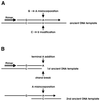DNA sequences from multiple amplifications reveal artifacts induced by cytosine deamination in ancient DNA
- PMID: 11726688
- PMCID: PMC96698
- DOI: 10.1093/nar/29.23.4793
DNA sequences from multiple amplifications reveal artifacts induced by cytosine deamination in ancient DNA
Abstract
We show that DNA molecules amplified by PCR from DNA extracted from animal bones and teeth that vary in age between 25 000 and over 50 000 years carry C-->T and G-->A substitutions. These substitutions can reach high proportions among the molecules amplified and are due to the occurrence of modified deoxycytidine residues in the template DNA. If the template DNA is treated with uracil N-glycosylase, these substitutions are dramatically reduced. They are thus likely to result from deamination of deoxycytidine residues. In addition, 'jumping PCR', i.e. the occurrence of template switching during PCR, may contribute to these substitutions. When DNA sequences are amplified from ancient DNA extracts where few template molecules initiate the PCR, precautions such as DNA sequence determination of multiple clones derived from more than one independent amplification are necessary in order to reduce the risk of determination of incorrect DNA sequences. When such precautionary measures are taken, errors induced by damage to the DNA template are unlikely to be more frequent than approximately 0.1% even under the unlikely scenario where each amplification starts from a single template molecule.
Figures



References
Publication types
MeSH terms
Substances
LinkOut - more resources
Full Text Sources
Other Literature Sources

